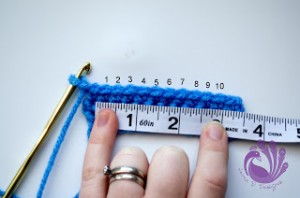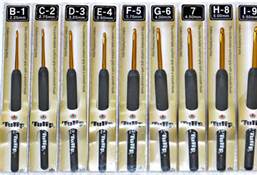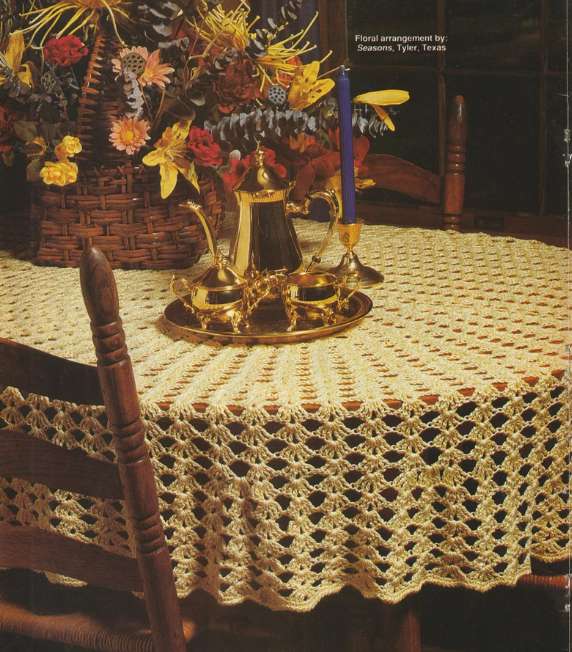I learn so much from my readers and from the other crochet sites I visit online as well as in books and magazines. I’d love to round up all those tips and have them in one location as a resource. So, I’m asking my readers to post their best tip in the Comment Section below. I’m really hoping we’ll get a lot of information gathered in one place.
I have a few tips I’ll start us off with. Some of them may be well known to most of you. For newbies, some of these will quite helpful (I hope). Here are some of my most useful crochet tips:
1. Use the right hook for the right job. Just because a pattern calls for a certain size hook, don’t forge ahead until you’ve checked to see if you get the same results with that hook that the designer did. If you crochet tighter or looser than average, you may well need to change hook sizes to attain gauge. There’s a very useful article about gauge here (the origin of the picture above).
2. Always check gauge (especially for garments)! If you successfully complete a garment that fits you without having checked gauge, it was just a fluke! This should probably tip #1.
3. Invest in good hooks and yarn. Don’t spend a month making a lovely afghan with inferior yarn. Your time and energy are as important as the finished product. If you’re a bit flexible and shop wisely for yarn, you can often find discounted sources for yarn that might otherwise be out of your price range. Those hooks featured here are my absolute faves! (Tulip Etimo Crochet Hooks, widely available.)
4. Make a photocopy of a pattern for your own use so that you can make notes and mark it up as you need without having to worry about it.
5. If a pattern appears complicated or difficult for you, use note cards or small pieces of paper and write down each step of the pattern on one card or piece of paper. Turn over each piece of paper as you complete that segment of the pattern.
Okay. This is my Top Five. I have lots more, but I’d rather read what you have to add to the conversation here. Please post as many tips as you’d like. Feel free to add a link to a website or video if that will better demonstrate your idea.



For me, the starting chain was a problem — too tight — making the bottom of an afghan bunchy. For a while, using one size larger hook for the chain and switching to the normal hook for the rest of the project worked okay. But the best solution (for me) was to crochet the first round into the BACK loop of the chain, not the top. It takes longer to manipulate that first row, but when the project is finished, it’s SO worth it! The bottom of that first row has lovely double-loops across, just like the top of the last row.
I read this tip on a blog long ago and have used it for years, now, with great success. Wish I could thank that unknown blogger for a great solution.
This one thing that I have used for years and kick myself when I don’t do it. When I lay my crocheting down, I put a clothes pin on the last stitch and hook. Also if I need that hook, I put the clothes pin through the loop and mark on the pin what the hook size is that I took.
For long patterns I highlight every other row or round to make it easier to follow. I have even used several colors to highlight the rows with to make it even easier.
I keep a notepad with my project so that if I have to get up for whatever length of time, I can write down which row I left off at ( and I write down the hook size because sometimes mine grow legs and walk off.. this way I know what I was using).
For hooks, they don’t have to be expensive to feel right in your hands. I buy inexpensive hook and then use polymer clay to make handles ( for metal hooks, you can bake the handles directly on them!) 🙂
One of my favorites: (hope I’m explaining it well) instead of chaining up to begin the next row or round, I work a stitch that will bring me to the correct height into the top of that last stitch. This 1) eliminates the gap that bugs me so much and B) give a nice edge on it’s own or to work a border into.
The best hint: Join a crochet group. JD has preached this on her blog before, and she knows whereof she speaks!
I use small crochet squares To get the know the yarn and how the stitches look like with it.
My article on this topic: http://www.aduoscriptum.de/en/kreatives/2013/05/gehaekelte-quadrate-zum-farbvergleich.html
Since crochet beginnings always curl up and get in my way, I usually clip something to the beginning of the row. This is needed for only the first 4-5 rows. I have used a clothes pin, a binder clip, even a pen stuck thru the stitches. Just about anything with some weight works to get that curl out of the way. I have even taken wooden clothes pins and carved the opening to make it smaller and smoother.
This is actually my daughter’s idea: she took a small plastic box with a lid (purchased at the dollar store) and drilled a hole in the lid. She feeds the beginning of the yarn through the hole and leaves the yarn in the box. Everything stays nice and clean and away from the kitties.
You may have to sand the hole or coat it with an epoxy glue to make it smooth enough for the yarn to go through.
I seem to be the only one who prefers plastic hooks over metal ones. the tip of the metal ones get caught more often because they just are not curved as much as the plastic ones.
When working on garments – take the pieces and let them “hang” for a few days. That way you can see the drape and decide if you need to make any adjustments prior to joining them together.
A good friend made me a set of safety pins that have a bead with the letters of the crochet hooks on each one. I pin one on the end of the row I stop on. This reminds me where I stopped and what hook I was using on the project.
Barbara r
Stitch Markers — do not fear them! LOL! I always attach one where I stop (to the loop and to the fabric). Also, when I have a looong beginning chain, I will put a stitch marker either at every 25 or 50 chains — so if I lose count, I do not have to go way back to the beginning!
Post-It Notes — I place one on my printed pattern, underneath the row I am currently working. I also write on the post-it as I complete a row.
When making garments for babies or children, I always replace the ‘worsted weight’ yarn with ‘sports weight’. Then, I increase the hook size to the next larger hook. That keeps maintains the required gauge.
Doing this eliminates that “Michelin Man” look, and it allows the garment to drape gently. OH YES, and it has that knit feel to it, too!
Great information.
Thanks!
jd